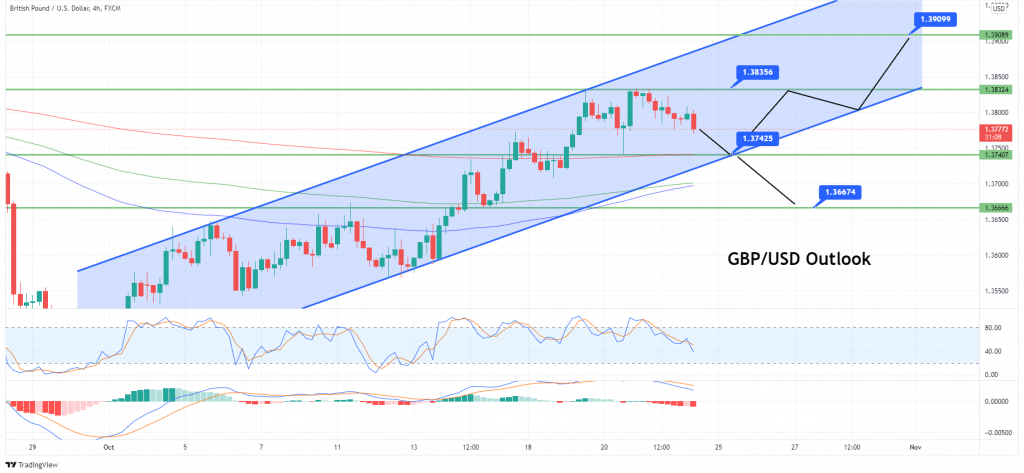GBP/USD Slips to 1.3800 amid Dismal UK Retail Sales, PMI Surprises
Please note that we are not authorised to provide any investment advice. The content on this page is for information purposes only.
- UK Office for National Statistics revealed that headline sales fell by 0.2 percent in September, which was unexpected.
- Headline seasonally adjusted IHS Markit / CIPS Flash UK Composite Output Index was 56.8 in October, up from 54.9 in September.
- Seasonally adjusted IHS Markit/CIPS Flash UK Services PMI Business Activity Index was 58.0 in October, up from 55.4 in September.
The GBP/USD pair retested daily lows in response to dismal UK retail sales. However, there was no follow-through selling as the pair was last seen trading slightly below the 1.3800 level.
UK retail sales fell by -0.2% – GBP/USD under pressure
Following the announcement of disappointing UK monthly Retail Sales numbers, the pair struggled to capitalize on its slight Asian session rise. Thus, the GBP/USD pair fell below the 1.3810 level. The UK Office for National Statistics revealed that headline sales fell by 0.2 percent in September, which was unexpected.
Excluding vehicle motor fuel sales, the core retail sales fell by -0.6 percent MoM. Whereas, economists predicted a 0.2 percent increase from the 0.7 percent fall reported in August. Thus, the news added selling pressure on the GBP/USD pair.
The data shows sluggishness in the economic recovery and follows this week’s lower UK consumer inflation readings. The incoming statistics may have dimmed prospects for a rate hike by the Bank of England in November, acting as a drag on the British pound. However, predictions that the Bank of England would raise interest rates before the end of the year, combined with a weak US dollar, helped minimize any significant decline in the GBP/USD pair.
A stronger dollar adds bearish pressure on GBP/USD.
So far, the USD has struggled to capitalize on the previous day’s modest recovery from three-week lows, but rising US Treasury bond rates have provided some support. Furthermore, the benchmark 10-year US government bond yield rose to its highest level since May 13, about 1.683 percent on Thursday, on expectations that the Fed will tighten policy sooner rather than later. The overnight statements from important FOMC members fueled market speculation.
Fed Governor Christopher Waller stated that the US central bank might intervene more quickly if inflation is too high. In addition, Atlanta Fed President Raphael Bostic indicated that he expects a rate increase in the late third or early fourth quarter of 2022. The underlying backdrop favors USD bulls and promotes the probability of the GBP/USD pair extending its overnight decline from five-week highs.
Manufacturing & Services PMI – UK recovery regains momentum
The October PMI statistics revealed a substantial and accelerated increase in UK private sector business activity, the most vital three months. Respondents to the survey reported increased corporate and consumer spending due to the lifting of pandemic restrictions. Service providers led the recovery, but manufacturers warned of another slowdown due to the acute workforce and material shortages.
Increased wage pressures and a worsening global supply chain instability led to the sharpest rate of input price inflation at UK private sector firms since the index began in January 1998.
UK Manufacturing PMI – The headline seasonally adjusted IHS Markit / CIPS Flash UK Composite Output Index was 56.8 in October, up from 54.9 in September, and maintained far above the neutral 50.0 mark.
UK Services PMI – The seasonally adjusted IHS Markit/CIPS Flash UK Services PMI Business Activity Index was 58.0 in October, up from 55.4 in September, and was above the critical 50.0 no-change value for the eighth consecutive month. The most recent growth was the strongest since July, while it was weaker than the high reached in May. (62.9).
Service providers primarily reported a sustained increase in client spending due to the lifting of pandemic restrictions, including increased export sales. There were still reports that staffing and supply chain issues were stifling growth.
What’s next on the economic docket?
Market players anticipate the US economic calendar, particularly the flash manufacturing and services PMI prints later in the early North American session. This, together with US bond yields, will have an impact on the USD price dynamics. Traders will also look for short-term opportunities in the GBP/USD pair based on broader market risk sentiment.

GBP/USD price forecast: Upward trendline to support at $1.3742
Although the GBP/USD slipped below the 1.3800 level, the bullish bias continues to dominate the market. The weaker retail sales data drove selling bias in the pair. However, the GBP/USD pair has started regaining bullish momentum upon the release of positive manufacturing and services PMI figures.
On the bullish side, the GBP/USD’s immediate resistance stays at the 1.3856 level. The double top pattern extends this resistance on the 4-hour timeframe. Therefore, a bullish breakout of this level can extend the bullish trend until the 1.3909 resistance level. On the 4-hour timeframe, the GBP/USD has formed an upward channel that’s supporting bullish bias in the pair.
On the bearish side, the GBP/USD’s immediate support holds around the 1.3742 level. A break below the 1.3742 level can lead the GBP/USD pair until the 1.3667 level. While the RSI and MACD are showing divergence. For instance, the RSI is in support of a bullish trend, while the MACD is holding below 0, demonstrating a selling trend in the pair.
Therefore, the idea is to wait for the 1.3835 breakouts before entering a buy trade. While aggressive traders may take a buy trade above the 1.3760 support level.
Stay tuned, and all the best to my fellow traders!





